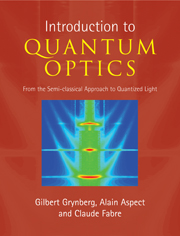Book contents
- Frontmatter
- Contents
- Foreword
- Preface
- Acknowledgements
- Part I Semi-classical description of matterlight interaction
- Part II Quantum description of light and its interaction with matter
- Part III Applying both approaches
- 7 Nonlinear optics. From the semi-classical approach to quantum effects
- Complement 7A: Parametric amplification and oscillation. Semi-classical and quantum properties
- Complement 7B: Nonlinear optics in optical Kerr media
- 8 Laser manipulation of atoms. From incoherent atom optics to atom lasers
- Complement 8A: Cooling to sub-recoil temperatures by velocity-selective coherent population trapping
- Index
8 - Laser manipulation of atoms. From incoherent atom optics to atom lasers
Published online by Cambridge University Press: 05 August 2012
- Frontmatter
- Contents
- Foreword
- Preface
- Acknowledgements
- Part I Semi-classical description of matterlight interaction
- Part II Quantum description of light and its interaction with matter
- Part III Applying both approaches
- 7 Nonlinear optics. From the semi-classical approach to quantum effects
- Complement 7A: Parametric amplification and oscillation. Semi-classical and quantum properties
- Complement 7B: Nonlinear optics in optical Kerr media
- 8 Laser manipulation of atoms. From incoherent atom optics to atom lasers
- Complement 8A: Cooling to sub-recoil temperatures by velocity-selective coherent population trapping
- Index
Summary
When the Nobel Prize for Physics was awarded to Claude Cohen-Tannoudji, William D. Philipps and Steven Chu in 1997 for the development of methods for cooling and trapping atoms using lasers, this was the reward for two decades of investigations not only touching upon the fundamental aspects of the light–matter interaction, but also leading to a range of applications. On the theoretical level, the advent of this field of research in the late 1970s stimulated the development of various theoretical methods for describing the radiative forces by which light affects the motion of atoms. On the experimental level, judicious use of the radiative forces exerted by lasers made it possible to obtain a drastic reduction of atomic velocities – in other words, to cool an atomic vapour. These advances were characterized by a remarkable cross-fertilization of theoretical and experimental innovations. It was not long before applications began to appear in the field of high-resolution spectroscopy, since ultracold, i.e. slow, atoms can be observed for longer periods, and this allows greater accuracy when measuring atomic resonance frequencies than could be obtained for atoms at room temperature. Based on such resonances, the most accurate clocks in the world use laser-cooled atoms or ions. Atom interferometry is another application of laser manipulation of atoms, which can be applied to measure inertial effects, due for example to the rotation of the Earth or the motion of a vehicle, with an accuracy that already exceeds traditional methods.
- Type
- Chapter
- Information
- Introduction to Quantum OpticsFrom the Semi-classical Approach to Quantized Light, pp. 599 - 650Publisher: Cambridge University PressPrint publication year: 2010

